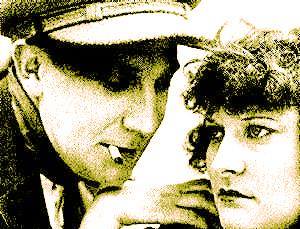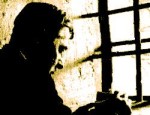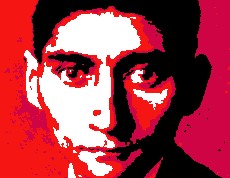Film Review

On paper, Coeur fidèle is nothing more than a trite melodrama, of the kind that dominated cinema of the early 1920s (on account of the genre's popularity). It contains all the familiar archetypes of the melodrama - the helpless orphan girl who is coerced into marrying the wrong man; the drunken brute of a husband; and the hero, a sympathetic everyman type - and it follows a narrative path that was even more well-worn than the asphalt on the Champs-Élysées. As if to downplay the intrinsic worth of the story, Epstein claimed that he dashed off the entire script in one night (in fact it was a collaboration with his sister Marie, who makes her one and only screen appearance in this film, as the kindly lame woman). What Epstein does with this film is far more important than its characters and the story it tells. His intention was to show that by employing his well-developed theories it was possible to elevate the vulgar art of melodrama to something of far greater merit, something that achieved a nearer approximation to real life than any other art.
Impressionistic veracity was at the heart of Epstein's philosophy of filmmaking. He was unimpressed with the expressionism practiced by some of his contemporaries, in particular German filmmakers such as Robert Wiene (whose Cabinet of Dr. Caligari he totally reviled), and saw this as nature morte (still life), the antithesis of what he felt cinema ought to be. Epstein's idea of impressionism hinged on two fundamental concepts - subjectivity and photogénie. Subjectivity is an easy concept to grasp and was something that other filmmakers were quick to pick up on; it involves exposing the feelings and motivations of the protagonists so that the audience is compelled to identify with them. Photogénie is a more nebulous idea which failed to gain acceptance. Epstein defined it as that essence of the film which arose from the filmmaker's intervention, something that goes beyond the merely material and mechanical and may loosely be termed the soul of the film. Today, we might perhaps call this the voice of the auteur, that unique character of one film which distinguishes it from another.
The pared back melodramatic plot of Coeur fidèle provided the perfect framework on which Epstein was able to explore and perfect his ideas of film impressionism. Even those who are familiar with films of the silent era will be surprised by what awaits them in this stylish masterpiece, by the sheer inventiveness and almost manic vigour that Epstein displays in his attempt to perform a Frankenstein-like miracle and inject life into the moving image. The film has been described as an early example of realist cinema, presumably because a large part of it was filmed on location in the town of Marseille and it is set in a recognisably working class milieu, but Epstein rejected the realist label, and rightly so. Coeur fidèle transcends realism in much the same way that it transcends melodrama. It does not merely seek to copy life (as a camera operated by a blind monkey might do), it shows life as it is experienced, with all its joys and agonies as authentically rendered and as evocative as the poppies in a Monet painting. This is poetry, not documentary.
Repeatedly, the film's striking realist veneer is punctuated by Epstein's bravura stylistic flourishes. The most famous of these is the dramatic fairground sequence in which the villain Petit Paul makes Marie his unwilling bride whilst his rival Jean watches on in abject impotence. This sequence illustrates Epstein's penchant for rhythmic montage, in which specific lengths of film (measured in number of frames) are spliced together to achieve a rhythmic beat. Abel Gance, one of Epstein's heroes, had employed the same technique in some of his films, most notably in La Roue (1923). The impression this creates is startling, almost terrifying - a wild maelstrom of activity which simultaneously conveys Petit Paul's feelings of exuberant triumph and Marie's hopeless sense of entrapment. It is a grotesque parody of a wedding, with the bride resigned to her fate and enmeshed in streamers that symbolise the chains of marriage, whilst her true love watches in despair, powerless to break the enchantment that his rival has engineered. When the film was first seen, this sequence caused some spectators to be overwhelmed by dizziness and nausea.
Epstein's application of rhythmic montage is certainly impressive but what proved to have a far greater impact was the film's pioneering use of the close-up, which helped to redefine the language of cinema from the mid-1920s. Epstein was probably the first filmmaker to realise the dramatic value of the close-up and its potential for creating an empathic link between the audience and the protagonists in the film. It is no coincidence that Coeur fidèle has only a fraction of the number of intertitles that were commonly used in films of this type at the time. The human face is a far more expressive and eloquent communication device than an intertitle. Reams of exposition and dialogue become superfluous when the audience is allowed to see what is written in the facial expressions of the characters, expressions which offer a far more profound insight into their internal states than any quantity of printed or spoken words.
The close-up also obviates the need for the exaggerated expressions that characterised the style of acting in early silent cinema. By the standards of the time, the performances in Coeur fidèle are almost naturalistic, something that adds greatly to the film's realist edge and impression of modernity. This is particularly noticeable in Gina Manès's portrayal of Marie, which is distinguished by its stillness and intensity. The lead actress's wonderfully expressive eyes appear to do all the work, dead with despair one moment, shining with wistful yearning the next. The other characters also reveal their personalities and their intent through their eyes (which are indeed the windows of the soul) - compare the gentleness and compassion that gleams in Jean's eyes with the fury and murderous intent that blazes in his rival's. Today, cinema without the close-up would be unthinkable, but in 1923 it was an innovation, and one which Epstein exploits magnificently in this film. Notice how he also uses the technique to create tension between characters, most visibly in Jean and Petit Paul's fight scene and in the climactic confrontation at the end of the film. By rapidly intercutting between close-ups, Epstein evokes the full force of the murderous frenzy which takes his protagonists over and makes the resulting contest appear far more violent than it actually is. Such is the power of subjective cinema.
One other technique which Epstein uses effectively is superimposition, although this was hardly an innovation by this time (Georges Méliès had used it to perform his cinematographic magic in his short films of the early 1900s). Close-ups of Jean and Marie superimposed on images of the sea and the port of Marseille emphasise both their emotional proximity and their physical separation to great effect. Superimposition was a technique which had probably had its day by this time (it was distractingly arty and could only really be justified in dream sequences), although some filmmakers - notably Abel Gance and Jean Epstein - used it frequently and with great flair to suggest a mood or an idea in a poetic vein (such as the uneasy union of elation and resignation that is felt in Coeur fidèle's lively epilogue).
Surprisingly (given its crowd-pleasing subject matter), Coeur fidèle was not a commercial success. It is hard to know whether this failure was down to Epstein's innovative touches or merely a reflection of the declining appeal of the old-fashioned melodrama. The film did however find favour among some serious critics and filmmakers of the time, who were eloquent in their praise of its stylish innovation. Coeur fidèle was to prove a highly influential film, presaging not only several other great films of the silent era such as Carl Dreyer's Master of the House (1925) and F.W. Murnau's Sunrise (1927) (both of which took subjectivity to new heights) but also the poetic realist tradition of French cinema of the 1930s. The film's recent restoration (to near-pristine condition) and release on DVD and Blu-ray (e.g. in the Masters of Cinema range) provides a fitting and long overdue tribute to Jean Epstein, one of the great visionaries of cinema.
© James Travers 2011
The above content is owned by frenchfilms.org and must not be copied.
Film Synopsis
In the port of Marseille, Marie works as a serving girl in a shabby bar owned by her cruel adopted parents, Monsieur and Madame Honchon. She is in love with Jean, a sympathetic dockworker, but the Honchons intend that she should marry Petit Paul, a good-for-nothing thug with a violent nature. Submissively, Marie allows Petit Paul to drag her off to a fair where he claims her as his bride. Jean follows them and engages his rival in a fight. In the ensuing brawl, a policeman is stabbed. As Petit Paul takes flight, Jean is arrested and ends up in jail. A year later, Jean returns to Marie to find that she is living in a squalid boarding house, struggling to keep alive her sick baby whilst her husband, Petit Paul, squanders all his money on drink. A gossiping neighbour alerts Petit Paul to the fact that Jean has been seeing his wife. In a drunken frenzy, the enraged husband heads back home for the final showdown with his rival...© James Travers
The above content is owned by frenchfilms.org and must not be copied.
Similar Films
Here are some other films you may enjoy watching:- Les Hommes nouveaux (1936)
- Le Roman d'un jeune homme pauvre (1935)
- La Fille de l'eau (1925)
- The Manxman (1929)
- The Saga of Gosta Berling (1924)
Other related links:
Film Credits
- Director: Jean Epstein
- Script: Jean Epstein, Marie Epstein
- Cinematographer: Léon Donnot, Paul Guichard, Henri Stuckert
- Cast: Léon Mathot (Jean), Gina Manès (Marie), Edmond Van Daële (Little Paul), Claude Benedict (Mr. Hochon), Madame Maufroy (Mrs. Hochon), Marie Epstein (Crippled Woman), Madeleine Erickson (Woman of the Port)
- Country: France
- Language: French
- Support: Black and White / Silent
- Runtime: 85 min
- Aka: The Faithful Heart
The best films of Ingmar Bergman

Kafka's tortuous trial of love

The best of American film noir
